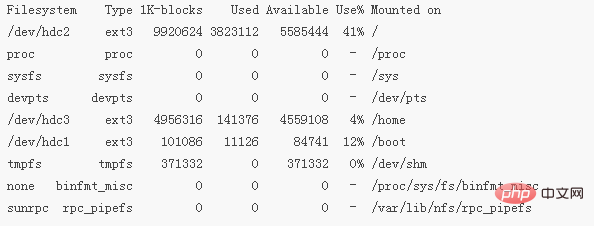
df is the abbreviation of "disk free", which is used to display the hard disk usage of each file system in the Linux system, including the total capacity, used capacity, remaining capacity, etc. of the hard disk partition where the file system is located; the syntax is: "df [option] [directory or file name]", if all parameters are omitted, all file system information in the system will be displayed by default.

#The operating environment of this tutorial: CentOS 6 system, Dell G3 computer.
Linux df (full English spelling: disk free) command is used to display the hard disk usage of each file system in the Linux system, including the total capacity, used capacity, remaining capacity, etc. of the hard disk partition where the file system is located.
Explanation: Data related to the entire file system is stored in the Super block, and the data mainly read by the df command is almost all for the entire file system, so the df command It mainly reads data from the Super block of each file system.
The basic format of the df command is:
df [选项] [目录或文件名]
Table 1 lists several commonly used options of the df command and their respective functions.
| Options | Function |
|---|---|
| -a | Display all file system information, including system-specific /proc, /sysfs and other file systems; |
| -m | Display capacity in MB; |
| -k | Display the capacity in KB, the default is KB; |
| -h | Display the capacity by yourself using units such as KB, MB or GB that people are used to; |
-T | Display the file system name of the partition; |
| -i | Instead of displaying the hard disk capacity, it displays the number of inodes. |
#If you omit all parameters and directly execute the "df" statement, all file system information in the system will be displayed in KB by default.
# df
Analysis: The meaning of each column of information displayed by the df command
Filesystem: Indicates which partition the file system is located in, Therefore, this column displays the device name;
1K-blocks: This column represents the total size of the file system, the default unit is KB;
Used: Indicates the amount of used hard disk space;
Available: Indicates the remaining hard disk space;
Use%: Hard disk space Usage rate. If the usage rate is as high as 90% or more, you need to pay extra attention, because insufficient capacity will seriously affect the normal operation of the system;
Mounted on: The mount point of the file system, that is, the hard disk The directory location to mount.
Usage example:
1. The df command is followed by the -hoption
Various capacity data of the file system will be displayed in the units that people are accustomed to (usually using GB or MB).
# df -h

2. The directory name is added after the df command
# df -h /etc
In this case, the df command will Automatically analyze the partition where the directory is located and display relevant information about the partition. From this, we can know how much capacity can be used in this directory.
3. The df command is followed by multiple options
# df -aT

Note that using the -a option will display many special file systems. These file systems Most of them contain system data, which exist in memory and do not occupy hard disk space, so you will see that the total hard disk capacity they occupy is 0.
Related recommendations: "Linux Video Tutorial"
The above is the detailed content of What is the abbreviation of linux df?. For more information, please follow other related articles on the PHP Chinese website!